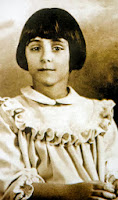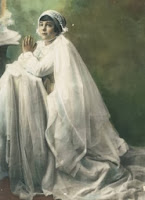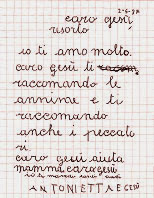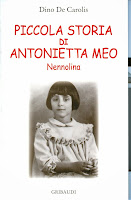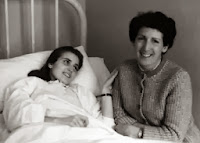I am always fascinated to see how lay people become saints as several more have made it onto the roster of new saints- or future saints. The first of whom is
BL. ODOARDO FOCHERINI whose life was nothing less than
![]() adventurous. A professional journalist during WWII he saved more than 100 Jews from the Holocaust by helping them cross the Italian border with false documents. After being detained by the Nazis, he died in a German concentration camp at Hersbruck, Germany in 1944 due to septicemia of the legs.
adventurous. A professional journalist during WWII he saved more than 100 Jews from the Holocaust by helping them cross the Italian border with false documents. After being detained by the Nazis, he died in a German concentration camp at Hersbruck, Germany in 1944 due to septicemia of the legs.
Bl. Odoardo was born in Carpi, Italy in 1907. He lost his mother when he was 2 years old. His father remarried and his adoptive mother loved him as her own son, directing his attentions towards life in the parish where Odoardo was formed in his faith.
He was of a sociable and friendly character and had many interests - the theater, journalism, songs from the mountains, playing the harmonica, bike riding and skiing. He also had a special love of the youth whom he constantly engaged in parish life, offering them spiritual formation.
In 1930 he married Maria Marchesi, and between 1931 and 1943 they had 7 children. His eldest daughter, Olga, still has the letters her father sent from prison, which are now part of their family treasure.
Odoardo first started helping Jews flee the Nazi persecution in 1942, but his large-scale effort did not begin until Sept. 8, 1943, when he asked his wife’s permission to help provide false identity cards so that Jewish refugees could cross the Italian-Swiss border. She told him: we and our children are safe, the Jews are not: go and help them.
At work, Bl. Odoardo always spoke against discrimination. He worked for 'L'Avvenire d'Italia,' a daily newspaper which still runs to this day. Its current editor believes Odoardo, the first journalist to ever be beatified, can teach modern journalists a very valuable lesson.
Olga was thirteen when her father was killed. She remembers him as a loving father who always wanted to play with his kids. He was also an affectionate husband who knew how to share with his wife both Christian values, with their work in the 'Azione Cattolica' and civil values, when he had a chance to save persecuted Jews.
Bl. Odoardo’s body was never found, since in all likelihood he ended up in the furnaces of Hersbruck. The official relic is his wedding ring, which he managed to keep from the clutches of the Nazi’s, miraculously smuggling it out of prison and back to his wife.
From the prison camp he wrote to his beloved wife Maria: "we must give everything in generosity, we can accept the cross, even if it becomes heavier, with the serenest of souls, and carry on.” He is the first Italian "Righteous Gentile".
BL. ODOARDO FOCHERINI whose life was nothing less than
 adventurous. A professional journalist during WWII he saved more than 100 Jews from the Holocaust by helping them cross the Italian border with false documents. After being detained by the Nazis, he died in a German concentration camp at Hersbruck, Germany in 1944 due to septicemia of the legs.
adventurous. A professional journalist during WWII he saved more than 100 Jews from the Holocaust by helping them cross the Italian border with false documents. After being detained by the Nazis, he died in a German concentration camp at Hersbruck, Germany in 1944 due to septicemia of the legs.Bl. Odoardo was born in Carpi, Italy in 1907. He lost his mother when he was 2 years old. His father remarried and his adoptive mother loved him as her own son, directing his attentions towards life in the parish where Odoardo was formed in his faith.
He was of a sociable and friendly character and had many interests - the theater, journalism, songs from the mountains, playing the harmonica, bike riding and skiing. He also had a special love of the youth whom he constantly engaged in parish life, offering them spiritual formation.
In 1930 he married Maria Marchesi, and between 1931 and 1943 they had 7 children. His eldest daughter, Olga, still has the letters her father sent from prison, which are now part of their family treasure.
Odoardo first started helping Jews flee the Nazi persecution in 1942, but his large-scale effort did not begin until Sept. 8, 1943, when he asked his wife’s permission to help provide false identity cards so that Jewish refugees could cross the Italian-Swiss border. She told him: we and our children are safe, the Jews are not: go and help them.
At work, Bl. Odoardo always spoke against discrimination. He worked for 'L'Avvenire d'Italia,' a daily newspaper which still runs to this day. Its current editor believes Odoardo, the first journalist to ever be beatified, can teach modern journalists a very valuable lesson.
Olga was thirteen when her father was killed. She remembers him as a loving father who always wanted to play with his kids. He was also an affectionate husband who knew how to share with his wife both Christian values, with their work in the 'Azione Cattolica' and civil values, when he had a chance to save persecuted Jews.
Bl. Odoardo’s body was never found, since in all likelihood he ended up in the furnaces of Hersbruck. The official relic is his wedding ring, which he managed to keep from the clutches of the Nazi’s, miraculously smuggling it out of prison and back to his wife.
From the prison camp he wrote to his beloved wife Maria: "we must give everything in generosity, we can accept the cross, even if it becomes heavier, with the serenest of souls, and carry on.” He is the first Italian "Righteous Gentile".
 |
| "Righteous Among the Nations" Awarded by Yad Veshem |























